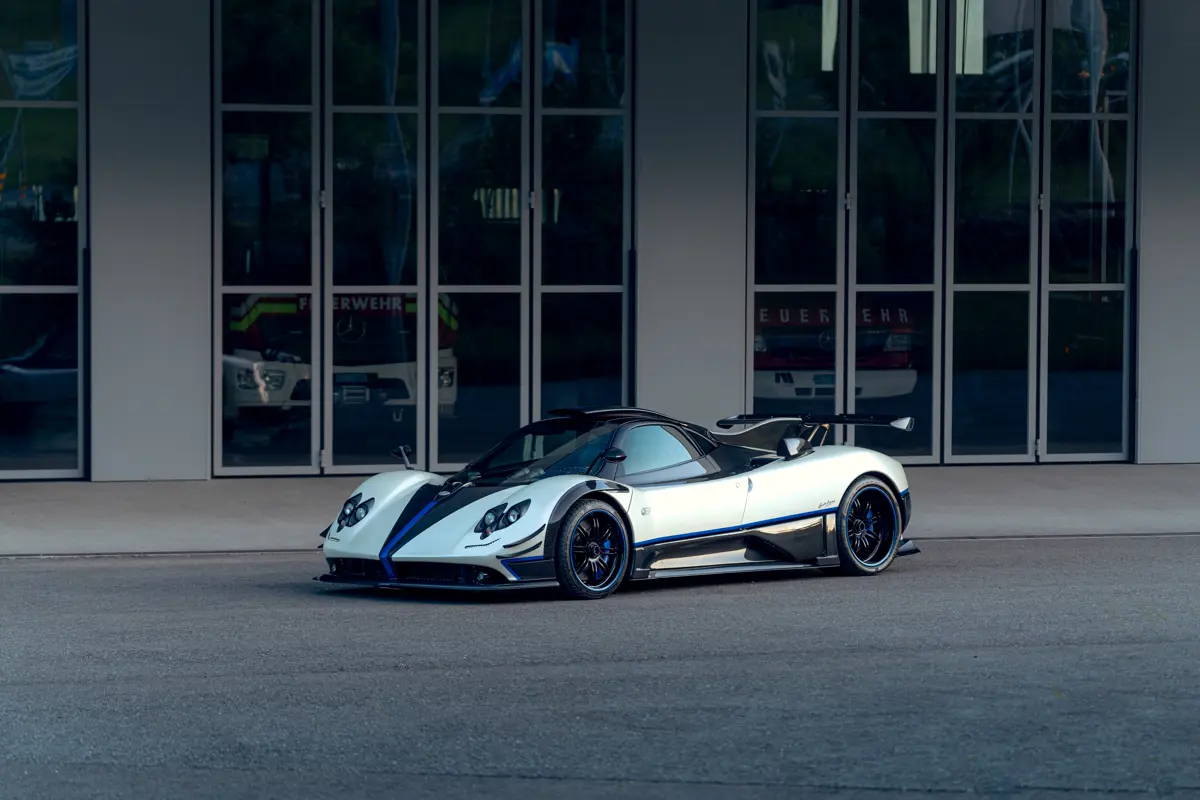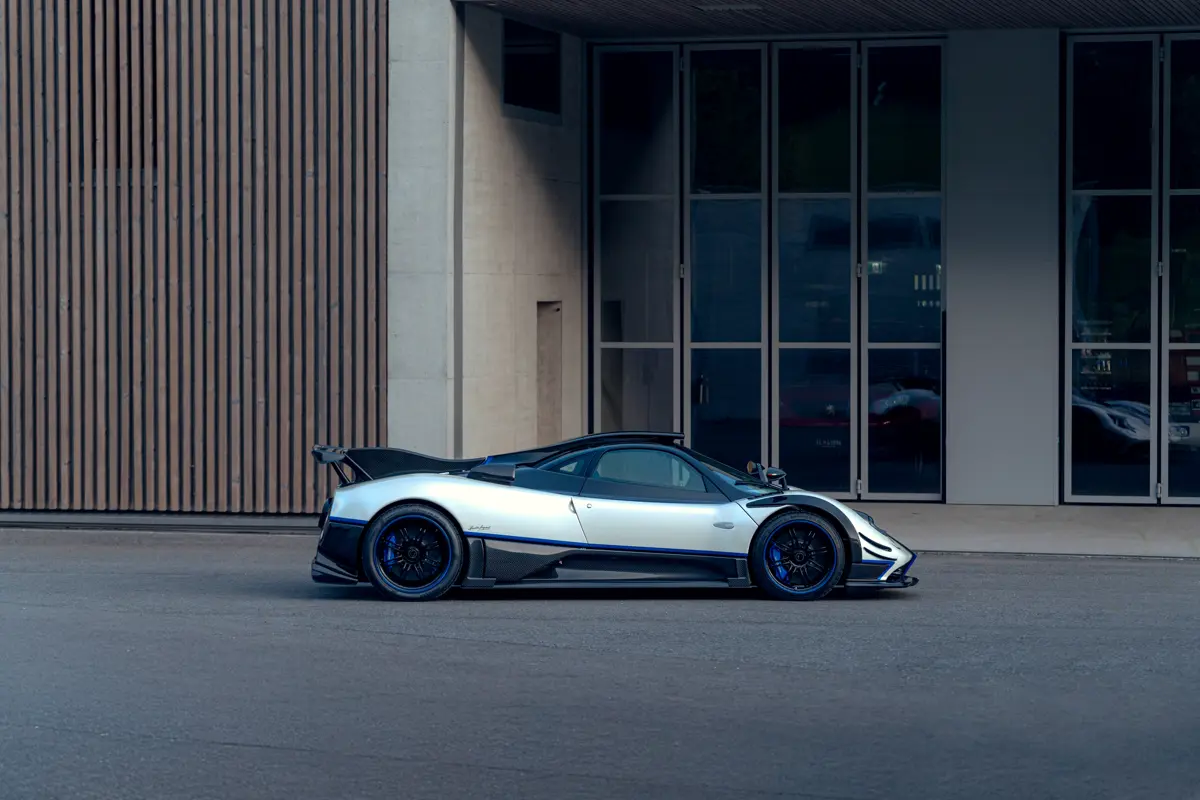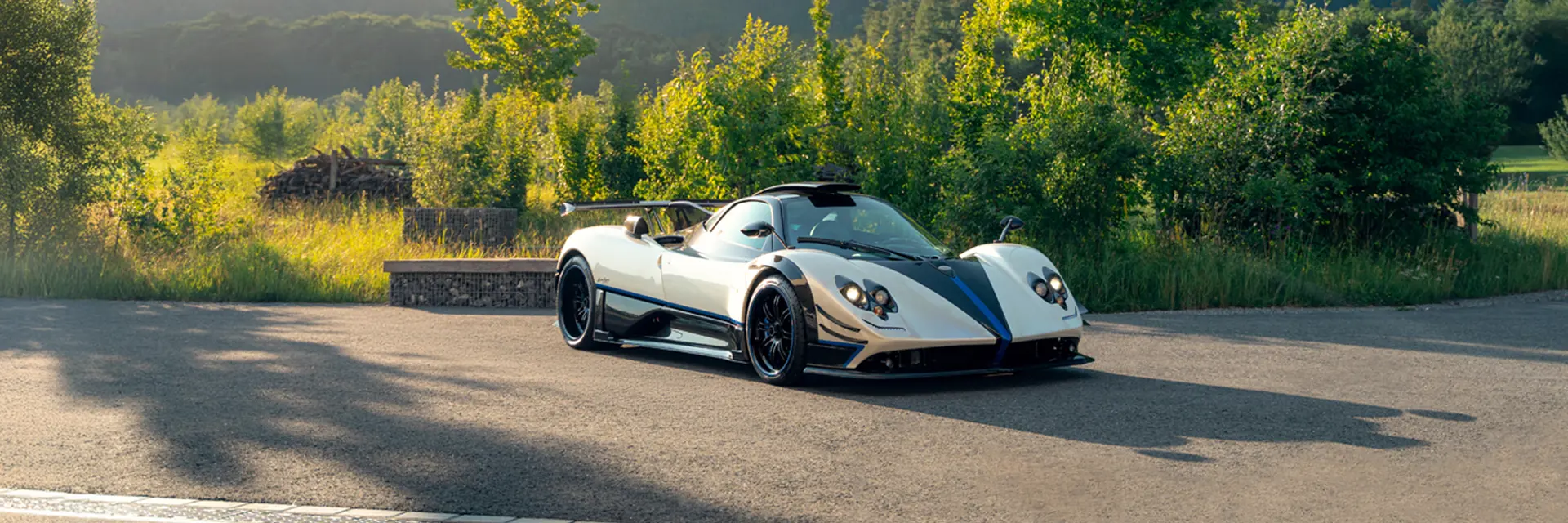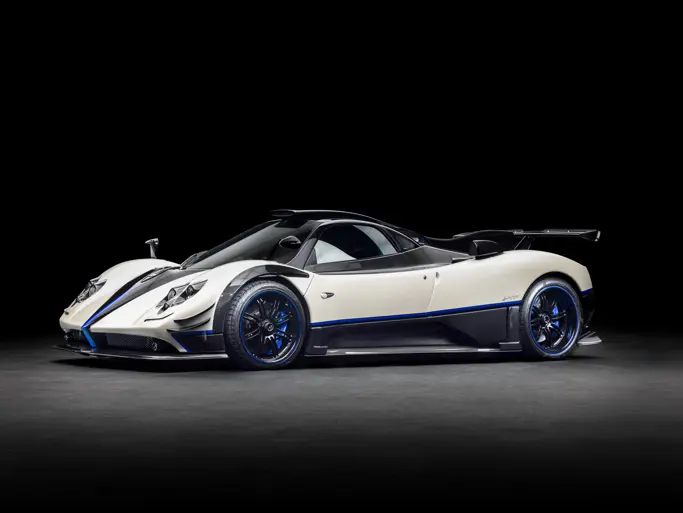From a hair-raising drive in Horacio Pagani’s personal Zonda back in 2012 to last year’s record-breaking auction result, Ben Barry charts the inexorable rise of the Pagani Zonda.
When I first visited Pagani Automobili on a sticky summer day in 2012, the man whose name was over the door gave me the guided tour.
He even let me drive his own personal Pagani Zonda—a supercar defined by its jewel-like detailing as much as its carbon fibre monocoque, carbon fibre bodywork, and 7.3 litres of naturally aspirated Mercedes-AMG V-12.
Thirteen years on, Horacio Pagani remains at the helm of the company he founded in San Cesario sul Panaro back in 1992—only Koenigsegg can compare when it comes to such continued ambition and independence in this rarefied realm.
And it seems the market increasingly appreciates the Pagani way of doing things—particularly when it comes to the Zonda.
Back in 2012, Pagani’s debut supercar would typically fetch maybe $450,000-$550,000 at auction, while the new Huayra launched at €849,000 plus taxes (today $960,000). (The Huayra was the reason I was actually out there all those years ago, by the way).
Today, while Huayra values are solid ($2.5-$3M is typical), it’s the Zonda that’s more valuable, with the few examples that come up typically selling for significantly more—$8.5M-plus for an S, perhaps $1.3M more for an F, with special editions and bespoke commissions stretching their legs beyond that. But at the RM Sotheby’s sale in Dubai in December 2024, a 2014 Pagani Zonda LM Roadster achieved an astonishing £11,086,250—not just a world record for Paganis, but a high for all 21st-century road cars full stop.

There had been special Zondas before the LM, of course—notably the models known collectively today as the Grandi Complicazioni series, which encompasses the Zonda Tricolore, Cinque, and 760. Pagani also produced the fearsome, track-only Zonda Revo.
A special client request designed to evoke Le Mans sport prototypes, the LM Roadster exploited Pagani’s learning that had been gained on both the 760 and the Revo. Highlights included a version of the Revo’s carbo-titanium chassis in road-legal trim, as well as the 760’s 7.3-litre naturally aspirated engine and seven-speed sequential manual transmission. (A one-off LM Coupe was also produced).
The LM also incorporated 60 dedicated components, including a distinctive new front bonnet—all the moulds, incidentally, remain in Pagani’s care, should the worst happen. An evolved suspension system and bodywork requiring its own dedicated aerodynamic study was also engineered, with the comprehensive development programme consuming six months on road and track. It’s why Pagani described the LM as the most challenging Zonda project it had ever undertaken.
The one-off LM was registered in Andorra and had covered 9,604 kilometres when it appeared at RM Sotheby’s second sale in Dubai. Bidding progressed quickly in million-dollar increments, before ticking up from $9.5M to $9.75M, $9.8M and finally going under the hammer at $9.85M—$11,086,250 with fees.

Squire notes two key drivers behind the rapid increase in Zonda values. “I think the first was Pagani continuing to be extremely exclusive but also shifting from being a little atelier producing cars to more of an internationally known brand,” he suggests. “The second was Pagani putting an official end to Zonda production, because there was perhaps a little confusion for a while.”
That’s because, even after the Huayra debuted and was subsequently replaced by the Utopia in 2022, Pagani continued to produce extremely limited runs of Zondas—the Cinque, Tricolore, 760, and indeed the LM Roadster that sold in Dubai. Then at Monterey Car Week in 2024, Pagani revealed the final Zonda—the one-off Arrivederci roadster, as commissioned by a US collector. It was chassis number 140.
“Officially declaring an end to production made the Zonda eligible for the show-and-display import exception to the US,” notes Squire. “That opened up a crucial new market and values increased accordingly.”
The very earliest models are now also available for import to the US without restriction, including the first-ever Zonda, the Zonda C12 that was shown at the 1999 Geneva International Motor Show. Later used for crash testing and homologation sign-off, it was restored by Pagani to celebrate the Zonda’s 20th anniversary in 2019.

If Pagani seemed to have appeared from the ether, the reality was rather different. Horacio Pagani arrived in Italy from his native Argentina in 1983, aged 27. Early in his career, he joined Lamborghini, where he worked on the Countach Evoluzione project, an entirely carbon fibre supercar concept.
He founded Pagani Composite Research in 1988, and subsequently Modena Design in 1992 as demand for his broader design, engineering, and prototyping services increased, with clients including Renault, Nissan, and Peugeot.
Work began on the Zonda in 1993. The concept was very much in the mould of the McLaren F1, which had debuted the year before. A carbon fibre chassis provided the foundations (when I visited in 2012, there were three autoclaves on site), to which extruded aluminium sub-frames were attached front and rear, cradling powertrain and suspension, with the latter comprising forged and machined wishbones all-round. There was also carbon fibre bodywork and a large capacity, naturally aspirated Mercedes-AMG M120 V-12.

The first C12 produced 394 brake horsepower—barely more than contemporary BMW M3 CSLs and 911 GTSs managed with half the displacement and certainly shaded by the 618 brake horsepower managed by the McLaren F1 from a comparable capacity. But with a dry weight of around 1,250 kilograms, it was still good for 4.2 seconds to 62 mph, 185 mph flat out, and plenty of muscle in between.
Evo magazine in particular championed the Italian newcomer, with frequent Zonda coverage helping Pagani elbow its way into a supercar establishment that’d proved the ruin of so many before it.
Pagani produced only five coupes and a single roadster version of that first model before the C12-S superseded it in 2000. At that point, capacity increased to 7 litres with the heavily revised M297 engine, taking power to 542 brake horsepower. Sixteen coupes were built before capacity increased again, this time to the 7.3 litres the Zonda would retain as power eased up first to 547 brake horsepower (Zonda S) then 594 brake horsepower (Zonda F) and eventually the 750 brake horsepower (or 760PS) developed by the Zonda 760, with which the LM shares its powertrain. Ultimately the Zonda’s V-12 would peak with 789 brake horsepower.
While stability control was integrated on later models, the first C12s featured only ABS braking and a rather primitive kind of traction control. “I think car makers have fallen asleep with electronics,” explained Mr. Pagani on that tour back in 2012. “You have to build a car that is safe without electronics, a car that is safe in principle.” Dynamic development was the responsibility of test driver and engineer Loris Bicocchi, with whom Pagani had worked at Lamborghini.
But Horacio Pagani was and remains passionate about the renaissance concept of art and science working together—in part a response to his frustration of design and engineering teams being siloed during his time at Lamborghini, the source of much internal friction, at least as he recalls it.

You can certainly see the interplay between function and aesthetics on the Zonda. Attention to detail is exquisite, from the milled and machined aluminium controls to the sumptuous leather and flawless weaves of carbon fibre—the latter showcased in visual carbon fibre that glinted in the sun on Mr. Pagani’s own Zonda.
It looked incredible. The Zonda is defined by its plunging clamshell front end with headlights like diamonds, a cockpit positioned dramatically forward with a pod of a canopy that appears more UFO than fighter jet, and broad, flat flanks that flow into a single-piece clamshell tail a little like a Porsche 917. There were more than a few echoes of the Sauber-Mercedes Group C cars—especially in the silver paintwork it wore at Geneva—but it was also distinctly otherworldly, like H.G. Wells does Le Mans.
I was out with development driver Davide Testi, experiencing the Huayra, when I got to drive Mr. Pagani’s Zonda for context. Open the door, climb over the sill and you settle into the low-slung carbon fibre sports seats. The cabin of Pagani’s own car was a little careworn—an R&D testbed for fit and finish, it’d racked up 45,000 miles when it sold a few years later—but visibility through the generous glazing and low scuttle was astonishing. You sit there at the tip of the arrow, the V-12 payload fanning out behind you, anticipation sky-high as the shrill starter twirls, bringing a little fanfare before the twelve-banger fires.
The clutch had a serious kind of weighting, the steering was appropriately meaty, but the Zonda was incredibly accurate to place on the road, with a ride defined by a supple, forgiving kind of gait. No fidgeting about, no tramlining, the Zonda felt very much optimised for crumbling tarmac and the often awkward primary undulations of rural Italian tarmac, particularly when you get out into the hills.

That AMG V-12 was a masterpiece, with effortless torque in its lower reaches, but with free-spinning precision as it ran towards 7,000 rpm, titanium con-rods slicing up and down—the noise was reminiscent of F1 machinery, defined by a deeper growl at moderate revs, a frenzied high-rpm scream, and with a gorgeous rasp and crackle accompanying every gear shift. It jumped up to those high notes like a cat jumping over a gate—it sounded and felt effortless, like all the mass had been trimmed off rotating and reciprocating components.
Peak torque was generous for a naturally aspirated motor at 553 lb-ft but because it arrived at 4,050 rpm—much later than a typical modern turbo unit—I had the confidence to really dig into the performance without fear of a sudden spike of torque lighting up the rear Pirellis.
The Zonda could still be quite lively, though, and as I followed Testi into a large, dry, and somewhat dusty roundabout, I think the combined effects of Testi’s race-honed abilities and the Huayra’s greater purchase on the surface drew me into entering said roundabout perhaps a little too quickly than physics might have suggested. Its rear end stepped out on a trailing throttle and I found myself winding on opposite lock to catch it while also watching Testi disappear from me at a fairly significant rate of knots. It was a surprise, and also a relief to find the Zonda’s chassis to be so benignly balanced and the slide really quite languid.
Earlier, Mr. Pagani had stressed his intention that the Zonda should have two personalities in one—‘the gentle lady and the bad one’—and here was that logic in slightly mouth-drying action.

They certainly do not make them like that anymore, and despite the record price achieved in Dubai, Michael Squire doesn’t see Zonda prices cooling any time soon.
“The collector car market is very generational, so people buy the cars they lusted after at school or university,” he comments. “Zondas aren’t really that old, so there are a lot of people out there making a lot of money who are going to want a Zonda for a long time to come.”
In other words, while the LM Roadster might be a one-off, its record price might well not be.




